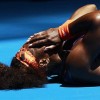by Randy Walker
@TennisPublisher
All eyes will be on the right ankle of Serena Williams for as long as she remains in the 2013 Australian Open following her scary ankle turn in her first-round win Tuesday over Edina Gallovits-Hall. While Williams won the match 6-0, 6-0, she moved gingerly and carefully while hitting the ball with aggressive abandon in order to end points quickly and get off the court to seek treatment. What can Williams – and other players that endure a similar injury – expect following a turned ankle injury? We corresponded with expert physician/orthopedic surgeon, Dr. Leon Popovitz, MD, founder of New York Bone & Joint who has served as a team physician for the U.S. Open, about the injury and the treatments and prevention for twisted ankles. The following is the question and answer session World Tennis Magazine conducted with Dr. Popovitz.
WTM: Did you see the injury to Serena Williams occur and what were you thoughts?
DR. POPOVITZ: “I saw the ankle injury. The first thought I had was “oh, no… is this Brisbane again?” But, then I saw Serena regain her composure. The ankle had a sudden roll then Serena suddenly released her full weight bearing. That along with her exceptional taping prevented potential significant damage.”
WTM: What kind of problems should Serena – or a player with a similar injury – expect in the next 48 hours to two weeks – which would be the time frame for her next singles match and through the rest of the tournament?
DR. POPOVITZ: “Serena should expect swelling and pain. Normally, it is even difficult to put full weight on the ground. Usually the most severe swelling and pain lasts for two to three days. Often, taping, air splints, elastics, or even cast boots may be warranted to be able to function. Overall, the majority of ankle sprains heal within about six to eight weeks. Protection from extreme motion, torque and stress is typically warranted for faster recovery. So, Serena will, likely, feel the greatest pain in the immediate few days. That makes her next match on Thursday, particularly, important. If she successfully overcomes that challenge then she will, probably, continue to have pain throughout the tournament but it will steadily improve.”
WTM: What kind of treatment will Serena – or a player that suffers a similar injury – undergo in the next two days to two weeks to help the injury?
DR. POPOVITZ: “Immediate treatment includes the gold standard that consists of R.I.C.E.-
Rest- limit walking on it
Ice- this is immediate to limit extent of swelling. Usually it is 20 minutes at a time every two to three hours. Wrapping the ice packs (while protecting the skin from burns) significantly improves function for high level athletes needing to return quickly.
Compression- taping, dressing, ace- bandages
Elevate- keep above the heart
Physical Therapy will, most certainly, be used to speed up Serena’s recovery. It is extremely effective in reducing pain, recovering range of motion and decrease swelling.
WTM: What can players do to help prevent injuries like this?
DR. POPOVITZ: “When you have a history of ankle sprains in the past using taping or air cast splints is very helpful in providing a sense of proprioception – this is the ability to sense the orientation and movement of your own body parts. This is a major step in recovery from an ankle sprain. When high level athletes need to return sooner (or recreational athletes need that extra sense of security) taping and air cast splinting is very effective. That extra sense of security may be the very thing that prevents a major injury”
WTM: Would Serena’s tightly tapped ankle have helped her from this injury becoming more serious?
DR. POPOVITZ: “Yes, as stated earlier. Other ways of preventing ankle sprains (and recovering from them) is peroneal tendon strengthening (outside structures of the lower ankle).
I recall Serena’s motivation during the early prime of her career, while I was team doctor for the U.S. Open Tennis Championships. She now has the same fulcrum of concentration and impetus as she did then. That is the concentration of a champion. I have seen it in her for years.

